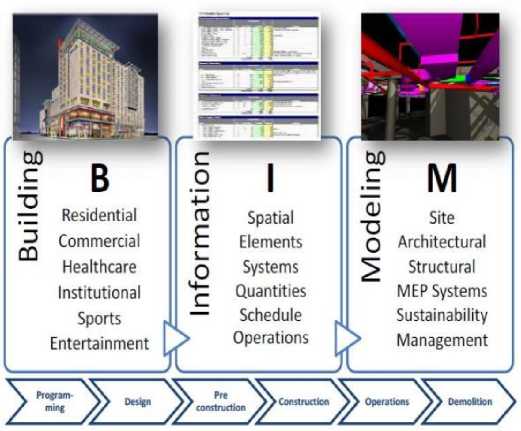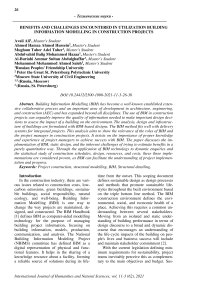Benefits and challenges encountered in utilization building information modelling in construction projects
Автор: Awali Ali, Ahmed Hamzah Ahmed Hussein, Moogam Taher Adel Taher, Abdulwahed Baleegh Mohammed Hazaa, Alburiahi Ammar Sultan Abdulghaffar, Mohammed Mohammed Ahmed Saleh
Журнал: Международный журнал гуманитарных и естественных наук @intjournal
Рубрика: Технические науки
Статья в выпуске: 11-3 (62), 2021 года.
Бесплатный доступ
Building Information Modelling (BIM) has become a well-known established extensive collaborative process and an important area of development in architecture, engineering, and construction (AEC) and has expanded beyond all disciplines. The use of BIM in construction projects can arguably improve the quality of information needed to make important design decisions to assess the impact of a building on the environment. The analysis, design and infrastructure of buildings are formulated with BIM-based designs. The BIM method fits well with delivery systems for integrated projects. This analysis aims to show the relevance of the roles of BIM and the project manager in construction projects. It insists on the importance of proper knowledge and experience of project managers to achieve success with BIM. The paper discusses the implementation of BIM, static design, and the inherent challenges of trying to estimate benefits in a purely quantitative way. Through the application of BIM technology to dynamic enquiries and the statistical study of construction schedules, design, resources, and costs, these three implementations are considered proven, as BIM can facilitate the understanding of project implementation and progress.
Project construction, structural modelling, structural detailing
Короткий адрес: https://sciup.org/170193816
IDR: 170193816
Текст научной статьи Benefits and challenges encountered in utilization building information modelling in construction projects
In the construction industry, there are various issues related to construction costs, low-carbon emissions, green buildings, sustainable buildings, social responsibility, natural ecology, and well-being. Building Information Modelling (BIM) is one way to change the way projects are maintained, designed, and constructed. The BIM Handbook [1] defines BIM as computer-aided modelling technology for the purpose of managing building project information, focusing on building information, models, production, communication, and analysis. The National Building Information Modeling Project (NBIMS) committee has defined BIM as a digital representation of physical and functional features. It helps in the sharing of a knowledge resource about a facility, forming a reliable source of solutions during its life- time from the outset. This scoping document defines sustainable design as design processes and methods that promote sustainable lifestyles throughout the built environment based on the triple bottom line method. The BIM construction environment defines the environmental, social, and economic health of a place. Achieving this requires a common understanding between several stakeholders. Moving from an isolated and static understanding of building performance in terms of design discourse to a broad and dynamic discourse that encourages an understanding of the life-cycle impacts of the building on people's lives and business success will include and maintain stakeholder commitment [2].
With the current legislation defining minimum requirements for sustainability, project teams inevitably perceive this as complementary to the main objectives and budget. Sus- tainability proposal is given in a meaningful commentary as "new concepts and tools that are integrative and synthetic, non-disciplinary and analytical and that energetically create synergies rather than just summation" [3].
The purpose of this paper is to provide an overview of the BIM concept, usage, benefits, risks, and related issues in the AEC industry.
As shown in Figure 1, BIM consists of a three-dimensional project model integrating design, planning, construction, and operation
-
[4] . The idea of BIM originated from the methodology of object-oriented parametric modelling [5]. The term -parametric defines a procedure by which an assembly is automatically tuned to preserve a previously discovered relationship [6]. The main difference between traditional 3D BIM and CAD technology is that the latter labels the building with independent 3D views such as facades, plans and sections, whereas the former does not label in this way.

Figure 1. A Schematic representation of BIM model [4]
BIM can be considered as a virtual process in which all functions are combined and organised. Today, BIM is perceived only as an advertisement for software companies. BIM can be taken as software and as an integrated method, which is shown in Figure 2 [7].
Drawing / CAD “ 2D =
Status quo ■
Necessity of printing c
Manual Work ■
Analogous processing cz Slow work ■
Disconnected part c
BINI
=> 3D/4D/5D/Xd
Ф Change of thinking
^> Electronic communication
Ф Automated z> Digital processing
^ Fast work
Ф Fully integr ated
Figure 2. Process of transitions CAD vs. BIM [7]
On the other hand, BIM applications are practiced in industries such as construction, information technology, and software and hardware. When considering BIM, a 3D model is often considered a fake. It should be noted that BIM is essentially a data package. It includes all information about the construction, design, management, and renovation of buildings. A 3D model is one of several possible ways to describe this information.
Recently, the concept of Integrated Project Delivery (IPD) has become a natural complement to BIM. In the USA [8], IPD has become the preferred project delivery system for all major BIM-related projects. Figure 3 shows the difference between the 'traditional' and 'BIM' process.
'BIN' Process

Concept 4 Design Documents 4 Drawrigs Construction 4 Operation ,
Relational Database AcCie Access, Constacton
(Design, Documents, Data) Sharing 4 Data Use 4 Operation
Figure 3. Difference between ―traditional‖ process and ―BIM process [8]
There are some specific aspects of BIM that helps in their effective implementation in project management. These attributes, developed progressively can be explained as follows:
-
• Constructability
-
• Investigation
-
• Quantity take-off
Construction makes up a significant part of all projects [9]. These can range from commercial projects to small mega mixed-use residential projects. The management of construction projects requires an understanding of modern management knowledge of the various construction procedures. Because of changes in organisational procedures, technology and new methods, the construction management process is different [10]. Construction project management refers to the sequence of activities to define the work process in the life cycle. Like the Project Management Body of Knowledge (PMBOK), the manager deals with project management planning, cost, quality, time, contract administration, risk, and safety management. The manager is also the liaison body between investors, designers, owners, engineers, professional team, and administrative staff. Usually, construction project management shares common and shared features of common projects. Consequently, the rules and approaches needed to manage common projects can be applied to this type of project.
CHALLENGES
The current review [11] shows that if project team members do not believe in the importance and benefits of BIM for construction projects, satisfactory results will not be obtained. [12] shows that the main areas of investment in BIM include hardware, software, and BIM workflow for collaborative interior design. [13] states that the problems of BIM can be divided into the following categories:
-
• technical challenges,
-
• skills and training challenges
-
• legal procedural challenges and
-
• economy which can obstruct the firms from upgradation of their available systems to a system which is BIM oriented.
Certain almost tangible advantages in the construction industry are the availability of information, productivity, and improved decision-making capabilities. Intangible benefits include competitive advantages, market access and better risk management. Challenges of elusive consideration include calculations in monetary terms. These studies are measurable and instinctive. Moreover, these benefits stem from business procedures and objectives. There is no self-explanatory expression to support the goals of the system. The lack of formal methodologies or procedures for creating a BIM business case leads to unequal speculation and incorrect evaluation. Approaches to evaluating information systems have been proposed. But most of them are prescriptive and reactive, depending on perception values.
BENEFITS AND ADVANTAGES OF BIM
Various construction project management sources recognize certain BIM advantages which are indicated as follows [14]
-
• Better performance and quality of the project
-
• Improved productivity
-
• Reduction of wastages
-
• Faster delivery
-
• New opportunities for revenue and
business Low construction cost
If BIM is seen as a centralised source, it can allow those involved in the construction industry to obtain the same version of the data. Consequently, the communication risk of project managers can be reduced. The analysis of feasibility and design solutions leads to improved building quality and performance. This is the key to achieving the benefits of BIM in the pre-construction phase. During transitions, further automatic low-level changes and accurate design of visualisations are required. There are various BIM tools that have been created to address sustainability issues in construction procedures from the beginning of design to facility management [15]. These technologies can help to achieve the results defined by sustainable assessment methods. The mechanistic approach needed to get credit cannot be stopped and can lead to deny the humanistic benefits and development benefits that BIM can bring in terms of stakeholder dialogue, shared understanding, and internalisation of values in sustainability.
Список литературы Benefits and challenges encountered in utilization building information modelling in construction projects
- Chuck Eastman, Paul Teicholz, Rafael Sacks and Kathleen Liston, BIM Handbook: A Guide to Building Information Modeling for Owners, Managers, Designers, Engineers and Contractors, Second Edition, Wiley, USA, 2011, pp. 1-648.
- Umit Isikdag, Building Information Models: An Introduction, Enhanced Building Information Models, 2015, pp. 1-12,.
- DOI: 10.1007/978-3-319-21825-0_1
- Umit Isikdag, The Future of Building Information Modeling: BIM 2.0, Enhanced Building Information Models, 2015, pp. 13-24,.
- DOI: 10.1007/978-3-319-21825-0_2
- Willem Kymmell, Building Information Modeling: Planning and Managing Projects with 4D CAD and Simulations, McGraw-Hill Construction Series, USA, 2008.
- Salman Azhar, Building Information Modeling (BIM): Trends, Benefits, Risks, and Challenges for the AEC Industry, Leadership and Management in Engineering, Vol. 11, No. 3, 2011, pp. 241-252, 10.1061/(ASCE)LM. 1943-5630.0000127.
- DOI: 10.1061/(ASCE)LM.1943-5630.0000127


